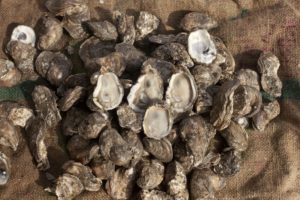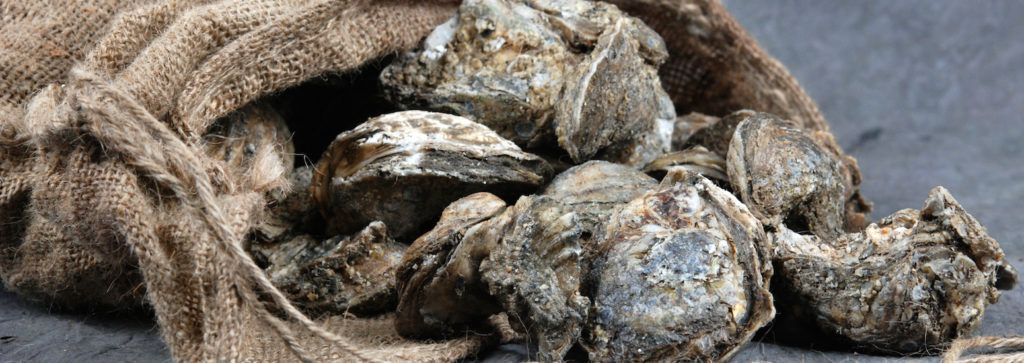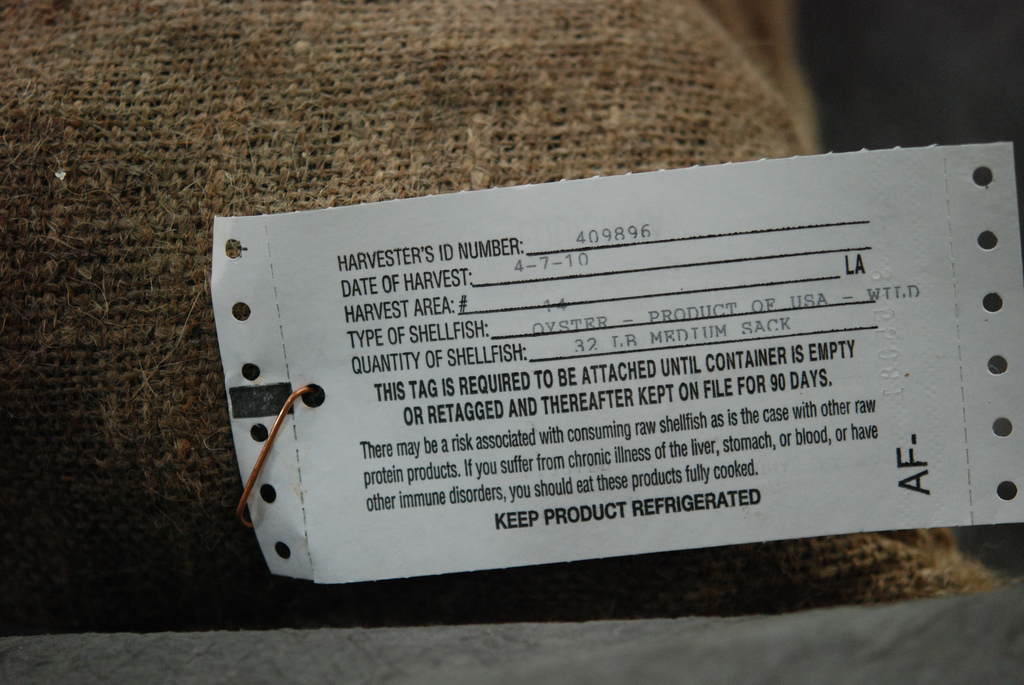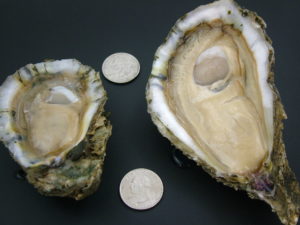Oyster
 The American or Eastern oyster, or Crassostrea virginica, is found intertidally and subtidally in estuaries (sounds, bays, bayous, tidal creeks) from Brunswick, Canada through the Gulf of Mexico.
The American or Eastern oyster, or Crassostrea virginica, is found intertidally and subtidally in estuaries (sounds, bays, bayous, tidal creeks) from Brunswick, Canada through the Gulf of Mexico.
Biology
Bivalve mollusk with two asymmetric shells attached at hinge. Shell weight and shape vary greatly depending on age, location and growing conditions. Shell color usually gray-brown. Left shell, attached to substrate, is usually more deeply cupped. Muscle scar purple in color and found inside the shells where adductor muscle attaches.
Oysters are filter feeders and capture phytoplankton, dissolved organic material and other appropriately sized particles from the water column as food. Adults accumulate glycogen reserves (fatten) during the winter months and develop ripe gonads during early-late spring. Rising coastal water temperatures stimulate external spawning of eggs and sperm by adults generally in the late spring/early summer. Planktonic, swimming life stages include trochophore larvae, which develop within the first 24 hrs after fertilization, then into shelled, veliger stages (D-hinge, umbo, late umbo and pediveligers). Tides and currents carry the larvae throughout the estuary for 12-21 days until pediveligers settle and crawl to find suitable hard substrate to attach and undergo metamorphosis into sedentary stage (spatfall). Spat (<1 inch) grow to seed (>1) and adult sizes (>2) with increasing shell size. Adults form vast reef communities providing critical estuarine habitat.
Oysters are euryhaline and can survive in nearly freshwater, but salinities <10ppt inhibit gonadal development. Spatfall increases with increasing salinity, but predation and disease stymie recruitment to seed and adult sizes above 15ppt, depending on location within the estuary.
Read more below, or download our fact sheet: Guide to Buying Live Oysters
- Buy & Transport
- Look For The Tag
- What's The Risk
- Alternative Oyster Culture (AOC)
- Breeding Oysters For AOC

Market size is generally >3 inches, but varies by state and harvest/farming method and market demand. Generally served raw on the half-shell and lightly cooked in many recipes.
Live or raw oysters can be purchased in sacks, mini-sacks and by count (dozen). When purchasing live unshucked oysters, make sure the commercial fisherman or processor is properly licensed to sell and a harvest tag is attached to the sack or stamped on the box to trace origin.
General Tips:
- Throw out any oysters with open shells
- Refrigeration temperature must be 45o F or less
- Live oysters should be consumed or frozen within 7-10 days from initial harvest
After purchase, move your live oysters directly to an ice chest for safe transporting.
To safely transport:
- Start by adding a layer of ice in the bottom of the chest.
- Place a layer of oysters on the ice.
- Add alternating layers of ice and oysters.
- Finally, add a good layer of ice on top.
Be sure to open the plug and prop the ice chest so that water runs out. Oysters should not be in standing water at any time. Additional ice should be added as needed.

A harvest tag is a tag placed on oyster products detailing harvest, shellfish and fishermen information. The main purpose of the tag is to describe how an oyster should be safely consumed. The color of the tag indicates if the product is safe for raw consumption based on harvest refrigeration times. A white tag oyster is best for raw consumption. Pink tag oysters can also be used for raw consumption but can’t be sold outside the State of Louisiana. Oysters with green tags must be sold for processing, and cannot be purchased for raw consumption.
Oysters filter water to feed. If the water contains bacteria, it can concentrate in an oyster’s muscle. Vibrio are pathogenic bacteria that naturally occur in the same coastal waters where oysters live. Vibrio parahaemolyticus and Vibrio vulnificus are two types of bacteria commonly associated with shellfish that can cause illness including watery diarrhea, abdominal cramps, nausea, vomiting, fever and chills. Onset of symptoms occurs within 24 hours of ingestion and lasts about three days. Severe illness is rare and typically occurs among people with a weakened immune system. Risks from raw consumption of oysters can be mitigated by rapid cooling of oysters during harvest and shorter storage times. This is why harvest tags are so important.
THERE MAY BE A RISK ASSOCIATED WITH CONSUMING RAW SHELLFISH AS IS THE CASE WITH OTHER RAW PROTEIN PRODUCTS. IF YOU SUFFER FROM CHRONIC ILLNESS OF THE LIVER, STOMACH OR BLOOD OR HAVE OTHER IMMUNE DISORDERS, YOU SHOULD EAT THESE PRODUCTS FULLY COOKED.
In Louisiana, any on-bottom, off-bottom or other means of growing oysters apart from directly on reefs or water bottoms is referred to as alternative oyster culture (AOC). This differs from traditional oyster aquaculture fishing methods in which oysters are harvested directly from natural or artificial reefs with a scraper or tongs.
While there are many different ways to operate an AOC oyster farm, they generally have a few key things in common: 1) oysters are containerized for growing, 2) oysters are grown as singles (i.e. not in clusters), 3) seed oysters are often produced in oyster hatcheries.
Oysters produce d through alternative oyster culture are more appealing to both chefs and consumers because they are typically uniform in size, meatier and have less grit, making them more ideal for either cooking or for raw consumption.
d through alternative oyster culture are more appealing to both chefs and consumers because they are typically uniform in size, meatier and have less grit, making them more ideal for either cooking or for raw consumption.
Farming oysters is one of the best examples of what sustainable farming can look like. In addition to being sustainable, oyster farming both on reefs and AOC provide significant environmental benefits. A growing body of research is documenting the large impact oyster farms have on water quality, nutrient removal and habitat availability for other economically and ecologically important juvenile fish and crustaceans.
Download our fact sheet on What is Alternative Oyster Culture?
AOC farms use oyster hatcheries which produce seed oysters for “planting.” One advantage is that the supply of seed oysters can be independent of wild oyster production. Hatcheries also allow oysters to be bred for improved or selected qualities that are desired both on the farm and on the plate.
Another aspect of oyster breeding comes in the form of triploid oysters. These are also known as spawnless oysters, as they are sterile. Since they do not reproduce, triploid oysters expend their energy into fast growth (good for the farmer) and fat meats all year long (good for the consumer). Non-triploid or wild oysters expend their energy into spawning or milking primarily during the summer months.
Triploid oysters are produced using a traditional breeding technique that is often found in the production of fruits. Some examples of triploid crops are bananas, ginger, seedless watermelons, strawberries and most satsuma varieties.

